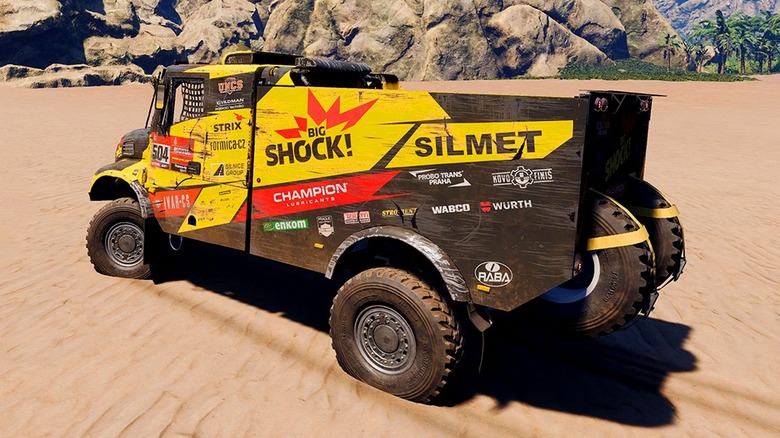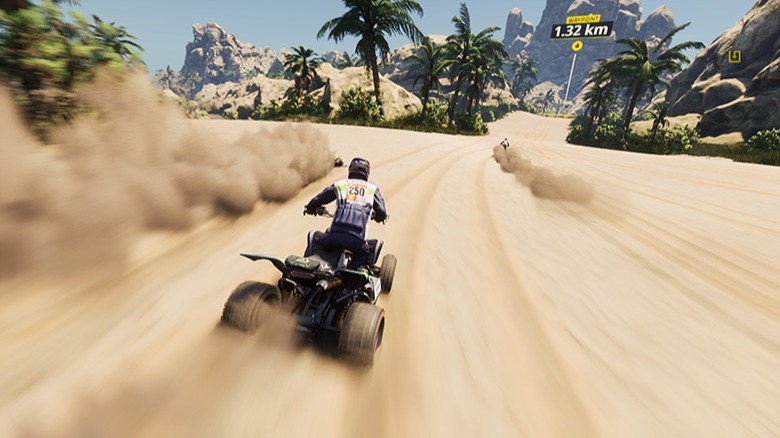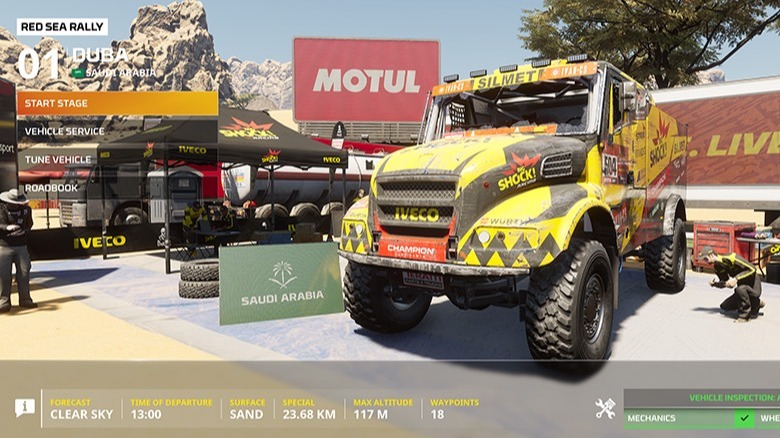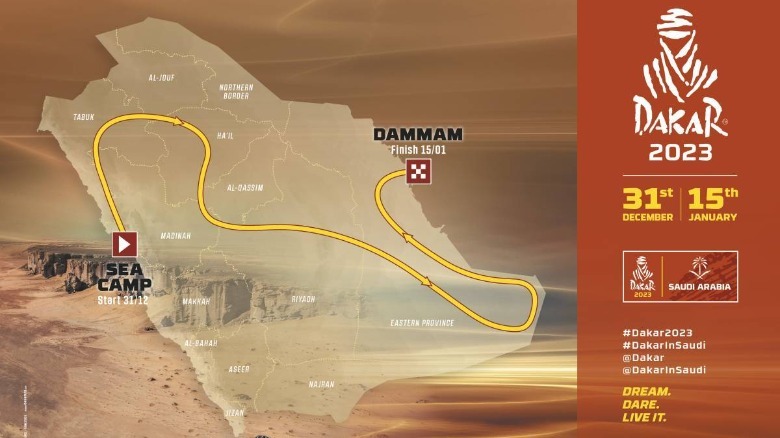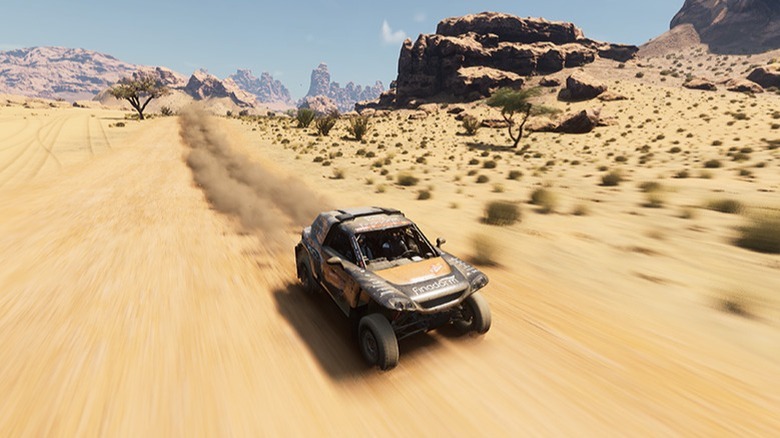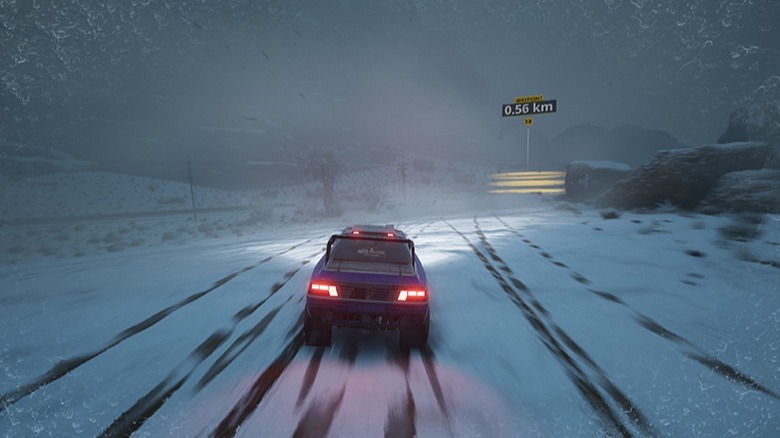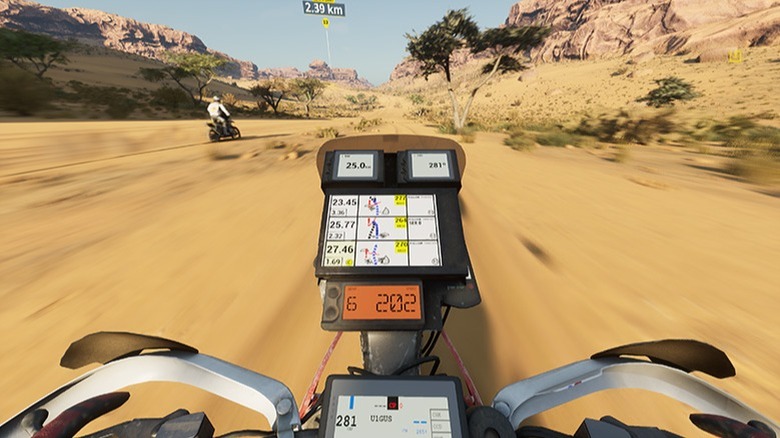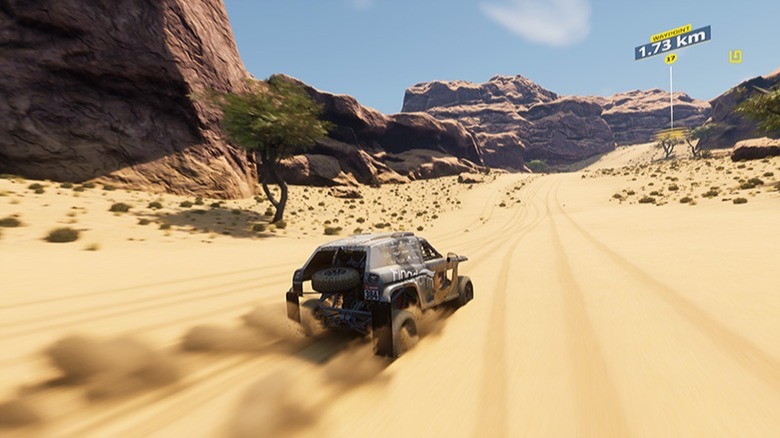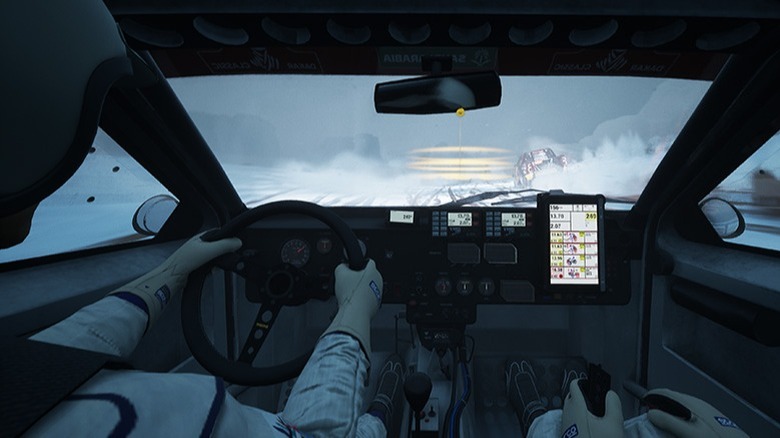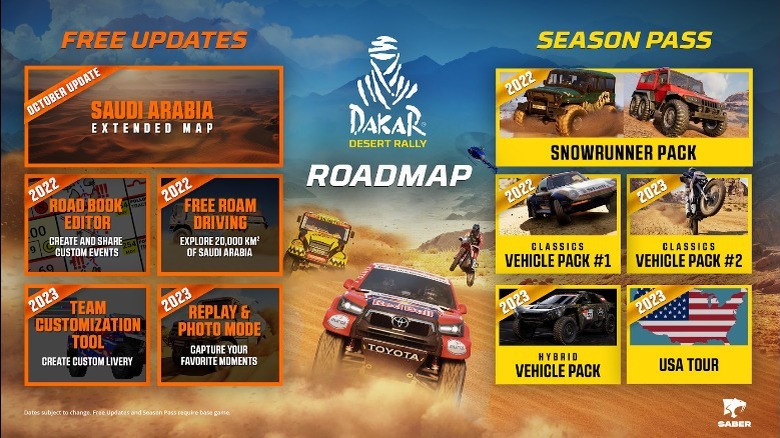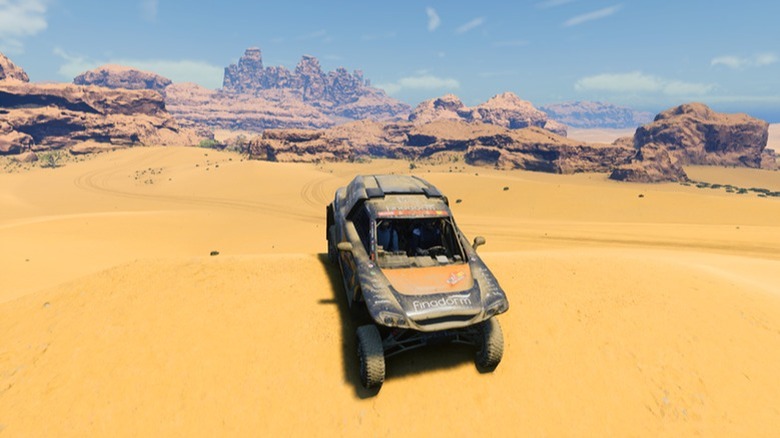Dakar Desert Rally Review: A Gem In Need Of Polishing
Last week, Saber Interactive released their latest rally racing sim, "Dakar Desert Rally," to Xbox, PlayStation, and PC. Previously, the team has stamped their name on the off-roading title "SnowRunner," and the "MX" series, so Dakar seems like a natural next step. The game is based on the real-world rally event it takes its name from, with authentic vehicles and tracks pulled from its 2020, 2021, and 2022 racing seasons. To bring Dakar to life, the team digitally recreated over 20,000 square kilometers of terrain in the Arabian desert, in which the current event takes place. The huge map also includes dynamic clock and weather systems to keep gameplay fresh and keep drivers on their toes.
You also get over 150 licensed vehicles, including cars, trucks, bikes, and ATVs. Most are from the modern racing series, but a few classic rally cars from the Group B era are also thrown in as bonus prizes. The trailer put out for the release certainly makes the game look like a thrilling, big-budget experience. Let's see if that appearance holds up to much scrutiny. For this review, I've played both the Xbox Series X and Xbox One versions of "Dakar," mainly Series X.
We were provided a review code for this game by the game's publisher in order to review this game.
Dakar Environment
To bring Dakar to gaming consoles, the Arabian Desert environment is so crucial to get right, and I think Saber has done it with this title. You may think that the location would lack variety, but the playable map is so huge that it includes tropical beaches, lush jungles, and snow-capped mountains in addition to the typical sand dunes. Occasionally, your route will even find a paved road. There are so many picturesque vistas in this game world, that it almost makes you want to slam on your brakes and take in the view for a moment.
This digitized natural beauty is enhanced by the dynamic lighting and weather system. The dunes and palm trees look especially gorgeous at sunset. Some events will have you racing under the cover of night, through a thunderstorm, or a blizzard. These all limit visibility and add to the sense of danger. Sometimes, a massive sandstorm will roll in from the horizon and threaten to sweep away the entire field of racers. That's when things get really exciting. Visual effects like lens flares and water droplets sticking to the game's camera help further the immersion. The physics of sand is particularly detailed, with your tires kicking up particles and leaving realistic track marks as they go.
Race Types
The Dakar event has routes stretching nearly 5,000 miles in total, taking multiple weeks to complete. In order to keep organized, the route is broken up into several bite-sized stages. These are what you run on in the game, with each stage taking around five or ten minutes to complete. Saber has included stages from the past three years of Dakar routes, so there are a ton of discrete events to choose from.
Desert Rally features three main race modes, with each also serving as a difficulty setting. The easiest, sport mode, uses a rallycross setup with all vehicles running at once. In this mode, you get highly visible checkpoints marking the course. If the player loses their way or crashes, they have the option of respawning at the last crossed checkpoint in exchange for a time penalty.
In professional mode, these checkpoints are rendered invisible, and the player must navigate using the in-game compass and vague GPS directions. Cars also run the stage at staggered times, so you're unlikely to bump into AI drivers. I found this mode to be a nice and authentic challenge, even if I did get hopelessly lost a couple of times.
The hardest mode is called simulation, which also requires manual navigation. In simulation mode, stages are chained together, taking up to an hour to complete. It also takes away your ability to reset at checkpoints, enforces speed limit rules, and must be unlocked by reaching experience level 25.
Driving Systems & Physics
The vehicle dynamics that underpin Desert Rally are solid, whether you're in a car, or on a bike. Controls feel realistic and weighty without being overly punishing. One thing to watch out for in this sim is that brakes lock up very easily, which sends lighter vehicles into an uncontrollable skid that can ruin your whole stage performance. Panic braking is unwise, so be cautious and proactive in driving.
The game features realistic damage modeling, so collisions have consequences. Cut a turn too sharp, and you might smack into a boulder, causing a wheel assembly to come flying off. To get back into the race, you can stop at the side of the road and make repairs on the fly. This costs money and incurs a time penalty. Repairs can also be done between stages, which is often required to pass safety inspection.
AI drivers in sport mode are not so advanced. They often behave like they're on rails, not really reacting to the environment around them. Drive too slow, and one will happily plow you off the road without a second thought. They also tend to corner too hard and roll over. Very often I drove past overturned vehicles, flailing in a panic like a cockroach on its back. Saber has said that they're working on improved AI in a future game patch. Online multiplayer is available for each game mode, but it took several minutes for me to find even one race partner.
Vehicle Selection
Another strength of Dakar is its wide variety of vehicles. They're separated into five classes: cars, trucks, dirt bikes, quad bikes, and side-by-side ATVs. Cars and side-by-sides are easiest to control, while open-air bikes can be twitchy and make the racer feel truly vulnerable. In sport mode, earning a podium with every vehicle type on an event will unlock a classic rally car for your garage. It's a nice incentive to learn and master each class. For each vehicle, tire and suspension settings can be tuned to subtly alter its physics and help prevent things like spin-outs. While piloting closed vehicles, there is a navigator that vocally calls out directions to you. On dirt bikes and quads, you're on your own to read the GPS and compass.
My favorite class, and one completely unique to Dakar, is the trucks. These are modified semi tractors that have been outfitted with suspension lifts and onboard survival gear. They were originally created as service vehicles for the event, but someone eventually got the bright idea to race them, too. As you may expect, these trucks are heavy beasts, so you have to maintain as much momentum as possible to heft them over dunes. However, carrying too much speed on the downhill is a dangerous proposition. Slinging one of these behemoths around a corner as it threatens to tip over on you is an exciting challenge that you can't find in many other sims on the market.
Graphics & Performance
From a graphics standpoint, "Dakar Desert Rally" stands up against all the latest racing games. It makes full use of the Series X hardware, with those previously mentioned lighting and particle effects. At high speed, the game looks nearly photo-realistic, although you could certainly nitpick little details when paused. Framerate is a different story, with dropped frames occurring frequently. On Series X and PS5, you can put the game into Performance mode to aim for a steady 60 FPS. However the actual framerate averages about 45. In Resolution mode, the game maintains a 4K image while being locked to 30 FPS. You may prefer to use this mode, as it gives fewer dropped frames overall. Hopefully, some patches can come with further optimization. Xbox Series S consoles are permanently locked at 30 FPS.
Driving from a cockpit or bumper view can also help improve performance since the engine has to render a narrower field of view. For the sake of thoroughness, I also loaded "Dakar" onto an older Xbox One S console, and I was sorely disappointed with the results. The game had all of the same lighting and particle effects to my eyes, but performance took a hit. It struggled to hold even 30 frames per second, often dipping under 20. Textures also looked muddy and low-res, with terrible aliasing on some effects. This title really needs new hardware to run properly, and PC players will definitely need a serious GPU to do the job.
Controller Options
When starting out the Xbox gamepad, I found steering to be quite unresponsive and rumble too intense. Luckily, Desert Rally contains a suite of adjustments to tune the controls exactly to your taste. It took some trial and error, but I was able to get the controls feeling tight. Nearly maxing out steering sensitivity and slightly increasing linearity, while turning down rumble response. However, I thought the "correct" way to experience the sim would be on a proper racing wheel.
The second time I sat down with the game, I plugged in my Thrustmaster TMX. The wheel was immediately recognized, but I felt no force feedback. Letting go of the TMX only made it lazily return to the center like a cheap bungee cord setup. Thinking this may be a bug, I reset everything and tried again, with no improvement. So I go online and find in Saber's patch notes that they have added wheel support, but no force feedback, even though feedback sliders currently exist in the game's settings. Clearly, the developers couldn't get full wheel support ready in time for release. Paddle shifters can be used as a manual transmission option, but an H-pattern shifter cannot.
To market a title as a hardcore racing sim and then include half-baked wheel support is inexcusable, and the biggest problem I have right now with "Dakar." If Saber wants the game to have an active community for the game, then this is something they should address as soon as possible.
Update Roadmap
Saber intends to sustain "Dakar Desert Rally" with at least another year of extra content. The first free update comes this month, with additional Saudi Arabia stages. Later this year, custom events and free roam driving are slated to be added. This will open up the full desert map for players to explore. Next year comes custom livery editing along with replay and photo modes. The lack of proper photo tools in the current game is another pain point for me, especially when the map looks so good. Overall, you could argue that all of these features ought to have been included in the retail game at launch.
Over on the paid DLC side, we have several vehicle packs, including a crossover with SnowRunner and additional classic rally cars. The last piece of Season One content in 2023 will add United States courses, which piques my interest. The pack is officially called "USA Tour," so perhaps it will include both east and west coast environments.
Saber has also announced an upcoming 1.3 patch, which aims to address wheel support issues, fix the overly aggressive AI, and tweak some hard-to-find checkpoints in pro mode. However, there's no official release date for those much-needed features yet.
Pricing & Availability
"Dakar Desert Rally" is available on retail disc and digital download for PS4, PS5, Xbox One, and Xbox Series S/X. The PC version is currently listed on Steam. Pricing for the base game starts at $40, which is fairly cheap for a retail title. Additionally, you can buy the deluxe edition for $60, and get all the season pass content included upon release. If you choose to buy the season pass later, it'll amount to $29.99, for a $70 total price.
It's hard to draw a definite "buy or don't buy" verdict on this game. It has a solid foundation to build on, but the product in its current state feels incomplete and rushed. Everything in this package is really compelling, which makes the stuff that is missing even more of a bummer. The lack of an online player base at launch also doesn't inspire a lot of confidence. Furthermore, you'll definitely want to skip over this title if you're running old hardware. The system just won't be able to keep up.
That being said, I still like "Dakar," and I'll definitely pick the controller back up after this review. Saber Interactive has a chance here to make one of the best rally sims on the market, provided that they can keep patches and updates coming in a timely manner. Until then, the discounted price may be enough to tide some people over.
As of November 1, Dakar has received patches on all systems to address a few issues. Force feedback wheel support has been added for most current models from Logitech, Thrustmaster, and Fanatec. Manual shifters are now also functional. Driver AI has been tweaked to prevent aggressive driving, and stability has been increased on bikes and quads to help avoid spin-outs. The additional Saudi Arabia events promised in the official roadmap have also been added.
